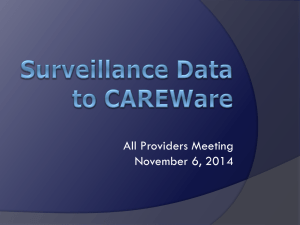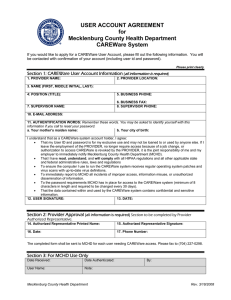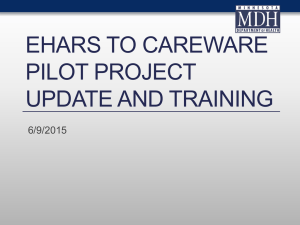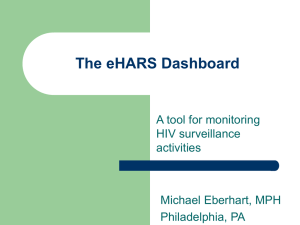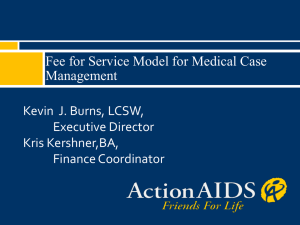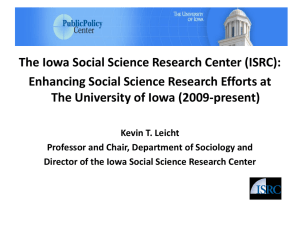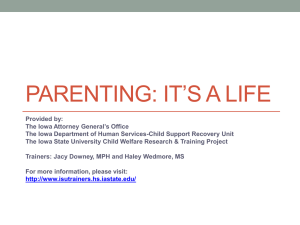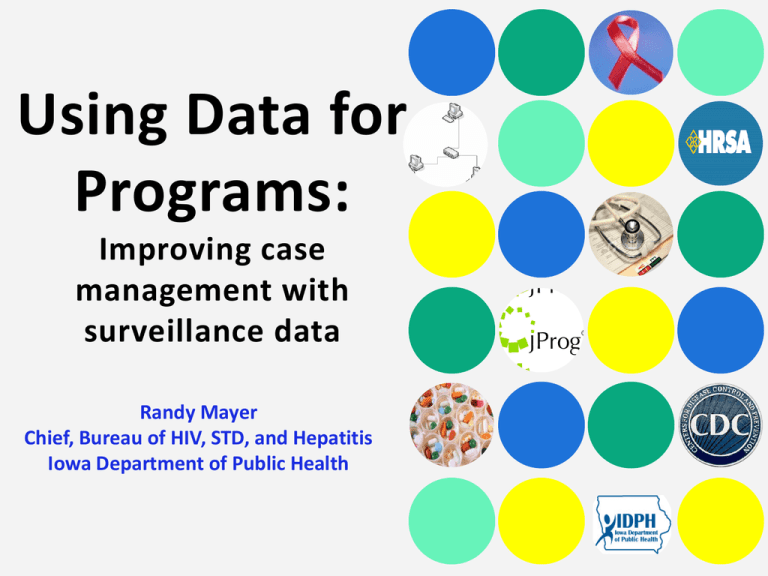
Using Data for
Programs:
Improving case
management with
surveillance data
Randy Mayer
Chief, Bureau of HIV, STD, and Hepatitis
Iowa Department of Public Health
Overall Goals
• To promote and allow better use of
surveillance data for programs.
• To plan for confidentiality and
security of data once it had been
transferred out of surveillance.
Specific Objectives
• Transfer viral loads and CD4+ cell counts from
eHARS, the surveillance database, to
CAREWare, the case management database.
• Use surveillance data and information for
retention and re-engagement programs.
Iowa’s Problem
• HIV surveillance data are governed by Iowa Code
141A.9.
• Very restrictive in how data can be released and
used.
• Allowed for release of diagnostic test results to
subject of test; to his/her provider; to anyone
with a signed release; or by court order (and then
only as a last resort).
• Allowed for use of medical information by
department staff for disease prevention only.
Other Problems
• Did not allow release of data outside the
department (e.g., case managers in other
agencies).
• Did not allow for discussions/release with
other state and federal health agencies.
• Did not allow for release of medical
information to case management agencies
working to re-engage people in care.
Our Approaches
• Revise the confidentiality section of Iowa
Code to allow for wider use and release of
data.
• Devise methods to allow us to work better
within the current law – at least with the
transfer of data to agencies that serve Ryan
White Part B program clients.
Iowa Code Change
• Update of Iowa Code
– Adding specific language to code to describe this use of medical
information (i.e., transparency).
141A.9 Paragraph 8. Medical information secured pursuant to
subsection 1 may be shared with other state or federal agencies, with
employees or agents of the department, or with local units of
government, who have a need for the information in the performance
of their duties related to HIV prevention, disease surveillance, or care of
persons with HIV, only as necessary to administer the program for
which the information is collected or to administer a program within
the other agency. Confidential information transferred to other entities
under this subsection shall continue to maintain its confidential status
and shall not be rereleased by the receiving entity.
Additional Steps
• Revise and strengthen case management forms:
Client Enrollment and Consent – add signed release of
surveillance data to case management agencies – all
clients must sign to be in Part B case management.
Confidentiality form – agency employees sign forms
parallel to what departmental employees sign.
Exchange of Data form – allows for continuous exchange of
information between agencies and medical providers or
care teams.
Release of Information form – from case management
agency to other entities.
Additional Steps
• Establish a data sharing agreement between
surveillance and the Ryan White Part B Program.
• Conduct assessments of data security and
confidentiality protections at the case management
agencies as part of site visits.
• Provide security and confidentiality training to
agency employees.
CAREWare Security
•Password set by Case Manager
•Locks out after 3 failed attempts, has to be
reset by IDPH
• User-specific token issues a unique code to
user
•Soft Pin (4-digit number) needed in addition
to token code
Why Labs are Needed –
Medical Case Management Model
• Ensure that clients are in care – HRSA
performance measure.
• Tie CD4+ cell counts to health outcomes.
• Monitor progress on goal of viral load
suppression.
• To give direct input/feedback to medical case
managers – e.g., adherence, linkage to and
retention in care.
Why Labs are Needed –
Medical Case Management Model
• Free up time for case managers to be case
managers (i.e., stop collecting lab data).
• Stop bothering medical providers when the
department already has the data in-house.
• Allow us to more easily analyze Ryan White
client-level data (e.g., unmet need for primary
medical care).
CAREWare in Iowa
• It is used by the Ryan White Part B Program to
collect client-level data on case management
and ADAP.
• All Ryan White Part B agencies in the state are
networked through the Internet on a
departmental server.
• Two Part B agencies are also Part C clinics;
other Part C agencies will be joining the
network soon.
eHARS to CAREWare
• All levels of viral loads and all CD4+ cell counts
are reportable to the department (since
2005).
• Iowa Department of Public Health (IDPH)
contracted with jProg to develop an eHARS
Import Tool for CD4+ cell counts and viral
loads.
Importing Labs into CAREWare
Lab data from eHARS
are put in Excel file
and placed on the
secure server for
CAREWare to receive.
eHARS Lab Importer
creates HL7 file from
Excel file then imports
that HL7 file.
Importer matches on
eURN from HL7 file to
client eURN in
CAREWARE.
eURNs that
do match
Agencies access their
clients’ information via
their own domain
through the Labs tab.
Sharing is turned on
for clients who have
signed consent forms
using Provider Setup
Wizard.
Records with eURNS
that are matched are
placed into
CAREWare in eHARS
Lab domain.
eURNs that
don’t match
No action taken on
record (discarded).
** All labs that match eURNs go into CAREWare, but not all clients will may have active
ROIs (and their data will not be shared with their case management agency).
Sample Import File from eHARS
Designed so that Personally Identifying Information (name, date of
birth) need not be placed in file.
Changes to Provider Setup Wizard:
“Clinical data are shared client by client, and only with providers that are
individually granted access. When a request is granted, all clinical data for that
client are viewable.”
CAREWare
Labs already entered by agency will have a different provider; they do not overwrite.
Caveat
• eURN is not a person-level variable in eHARS,
meaning that it is re-calculated after each
document entry (lab, case report, death
certificate).
• eURN needs correct first name (first 3 letters),
last name (first 3 letters), and sex to calculate
correctly.
• Because lab results often don’t include sex, eURN
is often incorrect in eHARS, and people have
multiple eURNs (one for each document).
Our Solution
• Assigned a new variable to each person in
CAREWare and eHARS. We use that to pull
data from eHARS.
• The data request from RW contains a list of
eURNs along with the new variable.
Surveillance matches on new variable and
leaves eURN from RW program.
“The true value of surveillance is
measured by its impact on public health
action and practice.”
Weinstock H, Douglas JM Jr, Fenton KA. Toward integration of STD, HIV, TB, and
viral hepatitis surveillance. Public Health Rep. 2009;124(Suppl 2):5–6.
Questions?
Randy Mayer, M.S., M.P.H
Chief, Bureau of HIV, STD, and Hepatitis
Iowa Department of Public Health
Randall.Mayer@idph.iowa.gov
515-242-5150

